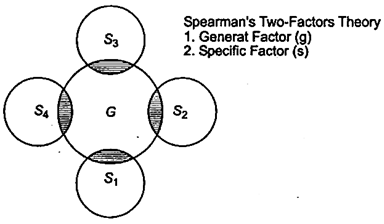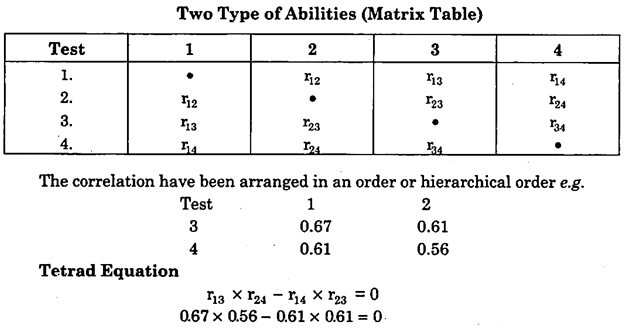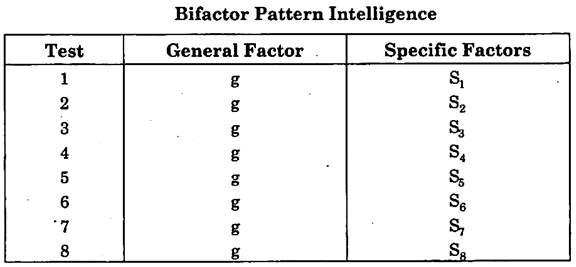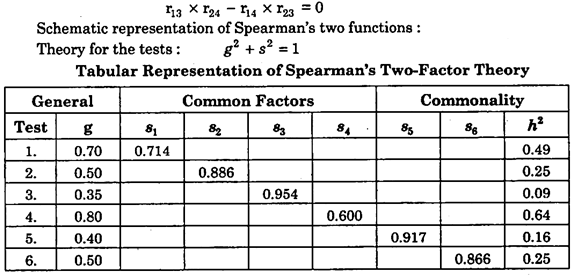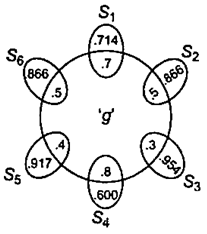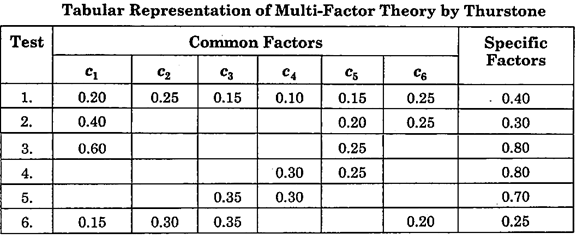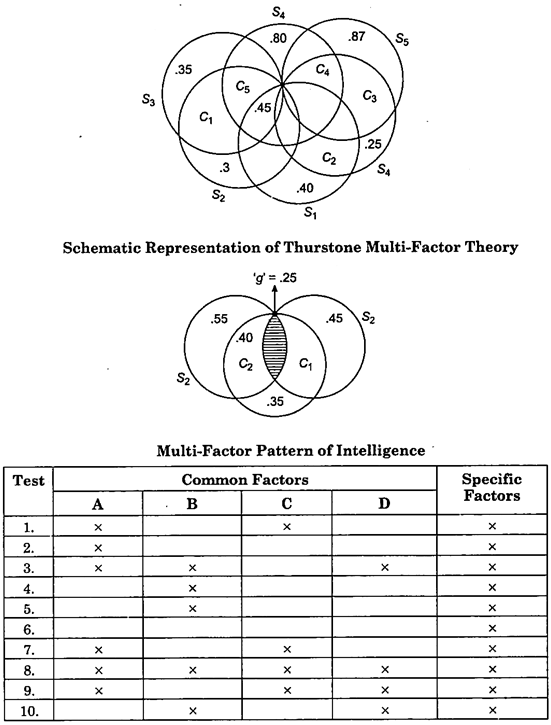ADVERTISEMENTS:
List of popular theories of psychology: 1. Piaget Theory of Development 2. Kohlberg’s Theory of Moral Development 3. Spearman’s Two-Factor Theory 4. Thurstone’s Multiple Factor Theory 5. Cannon’s Theory 6. The Psycho-Analytic Theory (Freud) 7. The Constitutional Theory (Sheldon).
1. Piaget Theory of Development:
Stages of Intellectual Development:
Piaget may be best known for his stages of cognitive development. Piaget discovered that children think and reason differently at different periods in their lives. He believed that everyone passed through an invariant sequence of four qualitatively distinct stages. Invariant means that a person cannot skip stages or reorder them. Although every normal child passes through the stages in exactly the same order, there is some variability in the ages at which children attain each stage.
ADVERTISEMENTS:
The four stages are- sensorimotor—birth to 2 years; preoperational—2 years to 7 years; concrete operational—7 years to 11 years; and formal operational (abstract thinking)—11 years and up. Each stage has major cognitive tasks which must be accomplished. In the sensorimotor stage, the mental structures are mainly concerned with the mastery of concrete objects. The mastery of symbols takes place in the preoperational stage. In the concrete stage, children learn mastery of classes, relations, and numbers and how to reason. The last stage deals with the mastery of thought.
We discovered that education is not something which the teacher does, but that it is a natural process which develops spontaneously in the human being. It is not acquired by listening to words, but in virtue of experiences in which the child acts on his environment. The teacher’s task is not to task, but to prepare and arrange a series of motives for cultural activity in a special environment made for the child.
ADVERTISEMENTS:
A central component of Piaget’s developmental theory of learning and thinking is that both involve the participation of the learner. Knowledge is not merely transmitted verbally but must be constructed and reconstructed by the learner. Piaget asserted that for a child to know and construct knowledge of the world, the child must act on objects and it is this action which provides knowledge of those objects; the mind organizes reality and acts upon it.
The learner must be active; he is not a vessel to be filled with facts. Piaget’s approach to learning is a readiness approach. Readiness approaches in developmental psychology emphasize that children cannot learn something until maturation gives them certain prerequisites. The ability to learn any cognitive content is always related to their stage of intellectual development. Children who are at a certain stage cannot be taught the concepts of a higher stage.
Intellectual growth involves three fundamental processes- assimilation, accommodation and equilibration. Assimilation involves the incorporation of new events into pre-existing cognitive structures. Accommodation means existing structures change to accommodate to the new information. This dual process, assimilation-accommodation, enables the child to form schema. Equilibration involves the person striking a balance between himself and the environment, between assimilation and accommodation.
When a child experiences a new event, disequilibrium sets in until he is able to assimilate and accommodate the new information and thus attain equilibrium. There are many types of equilibrium between assimilation and accommodation that vary with the levels of development and the problems to be solved. For Piaget, equilibration is the major factor in explaining why some children advance more quickly in the development of logical intelligence than do others.
A Piagetian-inspired curricula emphasizes a learner-centred educational philosophy. The teaching methods which most American school children are familiar with teacher lectures, demonstrations, audio-visual presentations, teaching machines, and programmed instruction do not fit in with Piaget’s ideas on the acquisition of knowledge. Piaget exposed active discovery learning environments in our schools.
Intelligence grows through the twin processes of assimilation and accommodation; therefore, experiences should be planned to allow opportunities for assimilation and accommodation. Children need to explore, to manipulate, to experiment, to question, and to search out answers’ for themselves—activity is essential.
However, this does not mean that children should be allowed to do whatever they want. So what is the role of the teacher? Teachers should be able to assess the child’s present cognitive level; their strengths and weaknesses. Instruction should be individualized as much as possible and children should have opportunities to communicate with one another, to argue and debate issues. He saw teachers as facilitators of knowledge—they are there to guide and stimulate the students.
Allow children to make mistakes and learn from them. Learning is much more meaningful if the child is allowed to experiment on his own rather than listening to the teacher lecture. The teacher should present students with materials and situations and occasions that allow them to discover new learning.
In his book to understand is to Invent Piaget said the basic principle of active methods can be expressed as follows:
“To understand is to discover, to reconstruct by rediscovery, and such conditions must be complied with if in the future individuals are to be formed who are capable of production and creativity and not simply repetition”. In active learning, the teacher must have confidence in the child’s ability to learn on his own.
Critique of Piaget’s Theory of Intellectual Development:
Erikson’s theory may be questioned as to whether his stages must be regarded as sequential, and only occurring within the age ranges he suggests. There is debates as to whether people only search for identity during the adolescent years or if one stage needs to happen before other stages can be completed. However, Erikson states that each of these processes occur throughout the lifetime in one form or another, and he emphasizes these “phases” only because it is at these times that the conflicts become most prominent.
Most empirical research into Erikson has related to his views on adolescence and attempts to establish identity. His theoretical approach was studied and supported, particularly regarding adolescence, by James E. Marica. Marica’s work has distinguished different forms of identity, and there is some empirical evidence that those people who form the most coherent self-concept in adolescence are those who are most able to make intimate attachments in early adulthood. This supports Eriksonian theory, in that it suggests that those best equipped to resolve the crisis of early adulthood are those who have most successfully resolved the crisis of adolescence.
2. Kohlberg’s Theory of Moral Development:
Lawrence Kohlberg’s stages of moral development constitute an adaptation of a psychological theory originally conceived by the Swiss psychologist Jean Piaget. Kohlberg began work on this topic while a psychology graduate student at the University of Chicago in 1958, and expanded and developed this theory throughout his life.
The theory holds that moral reasoning, the basis for ethical behaviour, has six identifiable developmental stages, each more adequate at responding to moral dilemmas than its predecessor. Kohlberg followed the development of moral judgement for beyond the ages studied earlier by Piaget, who also claimed that logic and morality develop through constructive stages. Expanding on Piaget’s work, Kohlberg determined that the process of moral development was principally concerned with justice, and that it continued throughout the knowledge’s lifetime, a notion that spawned dialogue on the philosophical implications of such research.
The six stages of moral development are grouped into three levels- pre-conventional morality, conventional morality, and post-conventional morality.
For his studies, Kohlberg relied on stories such as the Heinz dilemma, and was interested in how individuals would justify their actions if placed in similar more dilemmas. He then analyzed the form of moral reasoning displayed, rather than its conclusion, and classified it as belonging to one of six distinct stages.
There have been critiques of the theory from several perspectives. Arguments include that it emphasizes justice to the exclusion of other moral values, such as caring; that there is such an overlap between stages that they should more properly be regarded as separate domains; or that evaluations of the reasons for moral choices are mostly post hoc rationalizations (by both decision makers and psychologists studying them) of essentially intuitive decisions.
Nevertheless, an entirely new field within psychology was created as a direct result of Kohlberg’s theory, and according to Haggbloom et al. s study of the most eminent psychologists of the 20th century, Kohlberg was the 16th most frequently cited psychologist in introductory psychology text-books throughout the century, as well as the 30th most eminent overall.
Kohlberg’s scale is about how people justify behaviours and his stages are not a method of ranking how moral someone’s behaviour is. There should however be a correlation between how someone scores on the scale and how they behave, and the general hypotheses is that moral behaviour is more responsible, consistent and predictable from people at higher levels.
3. Spearman’s Two-Factor Theory:
He did not believe in the concept of faculty psychology that mental powers are independent of one another. According to Spearman theory, mental powers are unitary. He did research work at Oxford. He divided students in two groups and gave them tests in many school subjects and then calculated correlation in every two subjects, the correlation thus obtained was always positive. According to Spearman this is because something is common in all tests. This he called general mental ability, every work requires some specific ability which can be denoted by ‘g’ and’s’.
Spearman Gave Two Types of Abilities:
(a) General ability, and
(b) Specific ability.
Spearman’s two factors theory can be explained by his ‘Tetrad Equation’.
For example four tests are given in school subjects, their correlation matrix are arranged in following table:
These equations are always zero, because there is something common, factorial analysis method devised by Spearman (1927). We obtain two factor loadings.
Early in the present century, Spearman found that diverse test of mental abilities usually gave inter-correlations which could be wholly accounted only by a single general factor plus specific factors. Tetrad difference criterion is used.
Spearman was one of the first to attack the factor problem. He worked with groups of four tests.
Spearman’s Famous Tetrad Differences:
Divergence of these differences form zero.
Schematic Representation of Spearman’s Two Factor Theory:
Criticism of the Spearman’s Theory:
The factor analysis approach helped in given full-fledged theory of intelligence.
1. Tetrad equations are not always equal to zero, it means there is no general ability in all tests.
2. It is very difficult to calculate equation suggested by Spearman.
3. According to him each ability consisted of general and specific abilities, while every job has its own specific ability.
4. Thurstone’s Multiple Factor Theory (P.M.A.):
L.L. Thurstone also made a factor analytical study and Sound seven factors on the basis by application of this test on Chicago University students. He found seven factors when applied the test on children.
(a) Spatial Abilities (S)
(b) Perceptual Ability (P)
(c) Numerical Ability (N)
(d) Verbal Comprehension (V)
(e) Memory Ability (M)
(f) Deductive or Inductive Reasoning (R)
(g) Word Fluency (W)
Thurstone called these abilities primary or fundamental mental abilities (P.M.A.).
The loadings of multiple factor pattern is referred as simple structure. It is often used in analyzing tests of abilities. It requires three or four factors.
Multiple Factor Theory L.L. Thurstone:
The loadings of multi-factor pattern are referred to as simple.
Tabular Representation of Multi-Factor Theory by Thurstone:
5. Cannon’s Theory:
Cannon’s Theory regarding emotion also is known as the ‘Emergence Theory’ or the ‘Hypothalamic theory’. According to his view, the major part in emotional reactions is played by the excretion of the hypothalamus. In this view, the cerebral cortex is the centre of emotional experience while the internal brain or diencephalon, which is formed for hypothalamus and thalamus, is the centre of emotional expression, stimulation and effects.
The nervous impulses reach the thalamus through the sensory nerves. The thalamus attaches to this an emotional quality and passes it on the cerebral cortex so that the person experiences a specific emotion. While sending it on the cerebral cortex, the thalamus deflects a part of the nervous impulse to the viscera and the muscles. This results in a change in them which can be observed.
It is undoubtedly true that Cannon’s theory is more appropriate than James-Lange theory. It has been provide that the hypothalamus does have a hand in the control of emotions. The acceptance of this theory makes it possible to understand how the emotions remain unaffected by the spinal cord or by the mild reactions of the viscera.
It also explains the failure of adrenaline injections to arouse emotion. But his point of view is limited and one-sided, as Lashley has shown by his experiment; every aspect of emotion cannot be explained by this theory. In reality, the other parts of nervous system have as much a hand in emotions as the hypothalamus. For example, the cerebral cortex has a greater part in the adjustability of emotions.
6. The Psycho-Analytic Theory (Freud):
There are three aspects of this theory of personality:
(I) The dynamic aspects-
(i) Id
(ii) Ego, and
(iii) Super Ego.
(II) Topographical-
(i) Consciousness,
(ii) Unconscious, and
(iii) Sub-conscious.
(III) Economic aspects-
(i) Defence mechanism.
(I) The Dynamic Aspect of Personality:
The ego, id and superego are the parts of psycho. Freud’s theory made at about the same time as him shift from the ego libido polarity of motive to the life and death insects, had to do with doctrine of the unconscious. As to interpret the personality structure in terms of dynamic aspect of it. It may be studied in terms of ego, id and super ego.
(i) Id:
This has the following components:
a. The Id consists primarily of drives, inherited instincts or urges.
b. Id has no direct access to the environment.
c. Id has no sense organs or muscles.
d. Id is bottomless and blind.
e. Id is unorganized, unstructured, mixed desires libido and destructiveness.
Psycho-analysis helps maladjusted persons to substitute rational control for frightened repression and so to build up the ego at the expenses of the Id.
(ii) Ego:
It includes the following components:
The conscious self is also called the ego and the ego had the task of resisting the unconscious.
a. Ego has the direct access to the environment.
b. It functions through sense organs and muscles.
c. It learns through experience, it gets to know the danger to the environment and the necessity to check the id.
d. Its job is to take over the instincts from the id as far as it can, and make them conform the reality principle.
e. Ego task is to control the id.
f. Ego can be splitted into two:
(a) Execution, ego remains proper, and
(b) Watcher and moral critic or active.
g. The ego remains a somewhat ambiguous concept.
(iii) Super Ego:
It has the following operations:
The super ego corresponds to what we ordinarily call conscience, so far as conscience means a blind feeling of right and wrong rather than knowledge of what is good for us and socially valuable.
It is made up of moral elements. The superego appropriates some of the aggressive tendency for use against the ego.
Formation of Super Ego:
It consists of the following:
a. Interjection into the self of the external moral authority as represented specially by parents and other important persons in early life.
Super ego forms through personal contact or environment. Ideal are assimilated into the person through social personal relationship.
b. Direction on the interjected or individual on reality of some portion of the moralistic libido, so that individual loves himself. Interjected ideals began to act as self-ideals.
c. It cannot explain its command because source of its authority, rudiments of super ego where inherited from primitive man kinds and takes shape Oedipus complex.
The Oedipus complex:
Usually the boy’s libido fastens on the mother, the girls on the father. Oedipus is the here of Greek, the child Oedipus had killed his father to marry his mother.
(II) Topographical Aspects:
The psycho formation can be represented by to biographically as three aspects:
(i) Conscious,
(ii) Sub-conscious, and
(iii) Unconscious.
(i) Conscious:
Conscious is a part of psyche. The individual is fully aware or contingent of different type activity engaged by physic.
a. The individual cognitive conative, and affectively tendency are implied the conscious mind.
b. The ego of the individual is directly linked with conscious sphere.
c. The conscious part of psychic is sufficiently less in dimension as compared to the unconscious part. The 1/8th part of psychic is said to be conscious part.
(ii) Sub-Conscious:
It is directly related to the conscious but by little effort it can be brought to the level of conscious part of mind. The idea appears conscious par of mind, comes mostly from sub-conscious and fore conscious part.
Individual attention, thinking and concentration are directly explainable in terms of sub-conscious. It acts as threshold. The ideas never forget can recollect of recall on the power of conscious mind.
(iii) Unconscious:
It has the following characteristics:
a. The unconscious is more real and permanent aspect of human personality, mere than 3/4th of human psychic consists of the conscious.
b. The unconscious is vast and bottomless its mystery cannot be easily known motives.
c. The evidence for the unconscious part of psychic is the dream analysis, slip of tongue and slip of eye and other human behaviour which cannot be explained by conscious motives.
d. The unconscious is the sheet of instinctual organ of the Id. It is huge area occupied by instinctual forces of the individual.
e. The unconscious part of an individual reflect the true individual compared to his appearance i.e., real personality can be structural to know unconscious, dream analysis.
(III) Economic Aspect of Personality:
The nature exercise economy and follows the principle of test expended on existing total situation.
Law of parsimony (economy). Freud believes making a person try to make ill due to his over work and confine to bed. Similar the case in mental area, we try to live psychologically least expanse of this economy. It reflects different mechanism that used by human psychic.
1. Defence mechanism are those than toes resolve the conflict rather than specific fashion.
2. Minor mechanism are used as supplementary tools by the major mechanism.
Mechanism of Personality:
1. The mechanism is function, ways and means between Id, and super ego.
2. They tend to eliminate or reduce the security of conflict situation.
3. They are economical methods of resolution.
4. Not all conflict can be resolved, there are some conflict which continue and continuation of conflicts is sometimes very harmful for the growth of personality.
(i) Major Mechanism of Consciousness:
1. Repression, and
2. Discriminatory decision.
(ii) Major Mechanism of Unconsciousness:
1. Conversion
2. Regression
3. Sublimation
4. Reaction formation, and
5. Rationalization.
(iii) Major Mechanism of Both (Conscious and Unconscious):
1. Transference
2. Identification
3. Introjection
4. Projection, and
5. Displacements.
(a) Major Mechanism of Consciousness:
(i) Repression:
It is the part of conflict situation which is most unaccented. Unconscious may be forced into conscious by the ego when they occur, the mechanism is called repression. Inhibition where an individual consciously or purposely refrains from an activity.
(ii) Suppression:
Where an individual consciously forces unacceptable idea out of his mind successfully for period of time. Inhibition is deliberately or consciously avoid the situation.
(iii) Discriminatory Decision:
It is found in normal adult quite frequently and less frequently in children. Conflicts are resolved by discriminate decision and renunciation, weighting the pros and cons.
(b) Major Mechanism of Unconsciousness:
(1) Conversion:
It is the mechanism which represses energy, connected with the frustration basic drive is changed (converted) into the functional symptom bodily disease. The conflict is resolved by conscious or unconsciously into sickness. This mechanisms making weak physiologically and psychologically.
Conversion hysteria the disease due to the repression of derive, the energy thwarted and takes the form of disease. It is due to basic urges. Many a time headache may not be due to physical fatigue but due to thwarting the basic desire. The mental disturbance is due to basic urges.
(2) Regression (Means Going Back):
It implies the reversal of the ordinary progressive sequence of development and hence turns into more personality structure. The conflict is solved by flight into childhood.
Two types of regression:
(i) Ego regression, and
(ii) Libido regression.
Ego-regression is to return into earlier activity enacts as he is in the earlier stage may be in ego and libido. These two may occur libido regression without ego-regression. On the other hand, we seldom find ego regression without libido regression.
(3) Sublimation:
It is the solution of basic urges through the substitution a socially acceptable goal, there is redirection of basic urge into socially approved channel, the manifested behaviour are not only socially acceptable, but have definite social values. The unconscious is resolved flight into creative work, e.g., poet is interested in fine art, and many a time shows the tendency of sublimation. Expressing his desires in same forms his urges cannot be satisfied in original form.
(4) Reaction Formation over Compensation:
The development of behaviour which diametrically opposed to the unconscious urges or wishes, the conscious conflict is resolved behaviour denial of it. A person is preaching moral but may not moral man. Actually a people show and possesses more than his real.
(5) Rationalization:
The mechanism by which the individual justify his belief and action by going other reason than those activated along with other regression, sublimation reaction available in normal adult. No agreeable to prove his feeling with his own commands so rationalize his motive with logic for something actual reason is not given rationalization.
(c) Minor Mechanism:
(1) Transference:
It signifies the shifting of feeling of love-egoic cathoxies from one object and person to another. Freud gave an example of patient suffering from neurosis they show the tendency of love to the doctor. The patient derives same type of love feeling exhibit by patient toward the doctor as she exhibit toward her father, mother and husband.
(2) Identification:
It refers to the mechanism through a person attempt to mould his ego, after death of someone else believes himself to have some other person e.g., children make usually identify himself to his teacher at lower stage of education female teachers are proved more effective rather than higher stage. We identify to the person whom we get pleasure.
(3) Introjection:
It refers in corporation of the ego into itself of the outside environment of other individual of object apart of himself, empathy sympathy always with me in letters that sign of in introjection ‘you shall carry one.
(4) Projection:
It may be considered as inverse of introjection in that the ego attitude toward the environmental objects or other person’s characteristics of their own personality which are unexpected to the ego to seek faults in others. Try to look qualities of others, you are also weak you are also late. These are lame excuses.
(5) Displacement:
It refers of transfer of one object to another.
7. The Constitutional Theory (Sheldon):
The theory is developed by Sheldon. He insists on measurement of traits as they are continuous variables.
He has developed a psychology of personality which recognizes the importance of biological constitutional factors. He has emphasized on a continuous variable approach for the measurement of constitutional as opposed to the earlier method of classification on the basis of broad discontinuity. But, it resembles with older topologist.
All earlier topologist of personality assume that behaviour characteristics are related in same fundamental way to underlying biological factors.
Sheldon Thesis:
He postulates that human physique and personality can be adequately described in terms of three fundamental temperamental patterns.
Primary components of human physique are given below:
(1) Endomorphy,
(2) Mesomorphy, and
(3) Ectomorphy.
(1) Endomorphy:
This temperament has three components:
(a) The degree to which an individual shows rotundness.
(b) An under development of muscles and bones.
(c) Over development of fat and viscera especially the latter.
(2) Mesomorphy:
This temperament has the following characteristics:
The degree to which an individual shows:
(a) A predominance of development has bones muscles as opposed to the other bodily components.
(b) Possesses an athletic body which is hard well-proportioned muscular.
(3) Ectomorphy:
It has the following characteristics:
It is the component which determines the relative development of skin and nervous tissue over the other components.
An invalidity physique is related to the pre-ponderance of development of three fundamental embryonic-tissues:
(i) Endoderm:
Innermost layers of embryonic cells.
(ii) Mesoderm:
Middle layer from which muscles and blood survived.
(iii) Ectoderm:
Cellular layer from which skin, hair, central nervous system derived.
An individual is rated on seven point scale on each of the above components. In addition to these primary components, the individual may also be rated on the degree to which he demonstrates.
(1) Dysplasia,
(2) Gyndromorphy and
(3) Texture
(1) Dysplasia:
The extent to which a person shows a lack of harmony or markedly uneven mixture of the basic components in any part of his body. Ex-an otherwise endomorphic individual with the laps of endomorphs delinquencies, mental disease.
(2) Gyndromorphy:
The extent to which an individual has the bodily characteristics commonly identified with numbers of the opposite sex.
(3) Texture:
Texture is the degree to which an individual possesses a fine aesthetically pleasing body as revealed by the texture of his/her skin, hair and perhaps underlying cells.
Primary Dimensions of Temperament:
Temperament of an individual refers to his emotional and motivational nature. Behaviourally it is his reactive disposition.
Three primary clusters of traits could account for 1225 correlations among the traits were studied:
(1) Viscerotionia trait is closely associated with digestive and vishal process.
(2) Somatonia trait is associated with voluntary muscular system (Sematic structure).
(3) Cerabrotonia traits are the activities which have to do chiefly with attentional consciousness.
Relationship between Physique and Temperaments:
Under this study Sheldon selected 200 adults and obtained the following result:
1. Viscerotonia trait is most closely related to endomorphy temperament.
2. Somatonia trait is most closely associated with mesomorphy temperament.
3. Cerebrotonia trait is most closely related to ectomorphy temperaments.
On the basis of the relationship, temperament can be predicted on the basis of physique with a considerable accuracy and concomitantly physique with the help of temperature, but causal relationship cannot be established.
Criticisms of Sheldon Theory:
The following are the advantages and limitations of Sheldon Theory of personality:
1. Most of the studies done by Sheldon are on adult male subjects. Therefore, his findings related to biological traits and temperaments cannot be applied for female subjects, because their physique constitution is different from male. There is also difference between temperament of male and female.
2. Sheldon has used rating scale for measuring these variables; therefore, the observations have the ‘Halo effect’ of the rotors.
3. Somatic type is relatively in variant.
4. It considers, physique and emotional aspects of a person, but does not consider the intellectual and social aspects which are most important for the psychology of personality.
5. It has limited the scope for using this concept of personality in Education.
